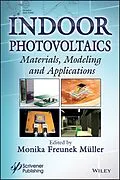This is the first and most comprehensive guide on the modeling, engineering and reliable design of indoor photovoltaics which currently is the most promising and energy efficient power supply for edge nodes for the Internet of Things and other indoor devices.
Indoor photovoltaics (IPV) has grown in importance over recent years. This can in part be attributed to the creation of the Internet of Things (IoT) and Artificial Intelligence (AI) along with the vast amounts of data being processed in the field, which has been a massive accelerator for this development. Moreover, since energy conservation is being imposed as the national strategy of many countries and is being set as a top priority throughout the world, understanding and promoting IPV as the most promising indoor energy harvesting source is considered by many to be essential these days.
The book provides the engineer and researcher with guidelines, and presents a comprehensive overview of theoretical models, efficiencies, and application design. This unique and groundbreaking book has chapters by leading researchers on:
- Introduction to micro energy harvesting
- Introduction to indoor photovoltaics
- Modeling indoor irradiance
- Characterization and power measurement of IPV cells
- Luminescent solar concentrators
- Organic photovoltaic cells and modules for applications under indoor lighting conditions
- High-efficiency indoor photovoltaic energy harvesting
- Indoor photovoltaics based on ALGAAs alloys
Autorentext
Monika Freunek (Müller) studied Mechatronic and Product Engineering at the Universities of Applied Sciences of Bielefeld and Furtwangen, Germany from 2002-2006. After graduation and postdoctoral research at IBM Research Zurich, she worked as a researcher and co-founder of a start-up. Monika Freunek is now at BKW, Switzerland, as an energy specialist. Her main focus in research is modeling of energy and photovoltaic systems under different application conditions. She is an expert in indoor photovoltaics and has edited Photovoltaic Modeling Handbook (Wiley-Scrivener 2018).
Inhalt
Preface xi
1 Will Photovoltaics Stay Out of the Shadows? 1
Joseph A. Paradiso
1.1 Introduction 1
References 6
2 Introduction to Micro Energy Harvesting 9
Monika Freunek (Müller)
2.1 Introduction and History 9
2.1.1 Brief History of Electric Generators and Loads 10
2.1.2 Forms of Energies and Energy Converters 10
2.2 Kinetic Energy 11
2.2.1 Oscillating Solid Objects 12
2.2.1.1 Human Motion 13
2.2.1.2 Vibrations 13
2.2.1.3 Flow of Gas and Fluids 14
2.2.1.4 Acoustic Vibrations 15
2.2.1.5 Elastic Energy 16
2.3 Thermoelectric Conversion 16
2.4 Electrochemical Potential 18
2.5 Electromagnetic Transmission 19
2.6 Atomic Batteries 19
2.7 Challenges 20
2.8 Conclusions and Outlook 20
Acknowledgment 21
References 21
3 Introduction to Indoor Photovoltaics 25
Monika Freunek (Müller)
3.1 Introduction 25
3.2 Indoor Spectra and Efficiencies 28
3.3 State of IPV Design, Issues, Approaches 31
3.4 Fields of Application 32
3.4.1 Customer and Office Applications 32
3.4.2 Ambient Assisted Living and Building Automatization 32
3.4.3 Industry, Agriculture, Horticulture, Retail, and Logistics 33
3.4.4 Relation of IPV to Outdoor Applications Hiking, Emergency Kits 34
3.5 Degradation and Lifetime Issues 34
3.6 Conclusions and Outlook 35
References 35
4 Modeling Indoor Irradiance 39
Monika Freunek (Müller)
4.1 Introduction 39
4.2 Fundamentals 40
4.2.1 Photometry and Its Impact on IPV 41
4.2.2 Comparison Measurements of Different Luxmeter Products and Settings 44
4.2.3 Conclusions for Indoor Irradiance Measurements 45
4.2.4 Available Data on Indoor Irradiance 45
4.3 Radiometric Solutions 47
4.3.1 Structure 47
4.3.2 Settings of the Studied Rooms 48
4.3.3 Investigated Installation Points 49
4.4 Analytical Model 52
4.4.1 Solar Radiation 52
4.4.2 Artifical Lighting 56
4.4.3 Interaction with Objects 60
4.4.4 Indirect Contributions of Solar Radiation 61
4.4.5 Final Results and Limits of Analytical Models 62
4.5 Simulations 62
4.5.1 Ray Tracing: Fundamental Principles 62
4.5.2 Radiance 64
4.5.3 DAYSIM 65
4.5.4 Calculation Methods and Parameters 66
4.5.5 Daylight Coefficient in DAYSIM 68
4.5.6 Environmental Parameters 69
4.5.7 Model Parameters 71
4.5.8 Results 73
4.5.9 Summary and Conclusion 85
4.6 Measurements 86
4.6.1 Available Measurement Methods 86
4.6.2 Long-Term Measurements Reference Year 89
4.6.3 Validating Simulation 94
4.6.4 Comparison Measurement Methods under Controlled Conditions 100
4.7 Discussion and Recommendation 103
4.8 Conclusion and Outlook 104
4.8.1 Autarky Factors 105
4.9 Acknowledgements 106
4.10 Symbols and Abbreviations 106
4.11 Constants 109
4.12 Abbreviations 109
Appendix 110
References 112
5 Characterization and Power Measurement of IPV Cells 115
Stefan Winter
5.1 Features of IPV Compared to Outdoor PV 115
5.1.1 Irradiance 116
5.1.2 Spectrum 116
5.1.2.1 Consequences of the Different Spectra Regarding Efficiency 117
5.1.3 Incident Angle Distribution 117
5.1.4 Modulated Light Sources 117
5.1.5 Further Effects 118
5.1.6 Standardization 118
5.2 Calibration Chain and Quality Management 119
5.2.1 Basic Laboratory Measurement Methods for the Seconda...
